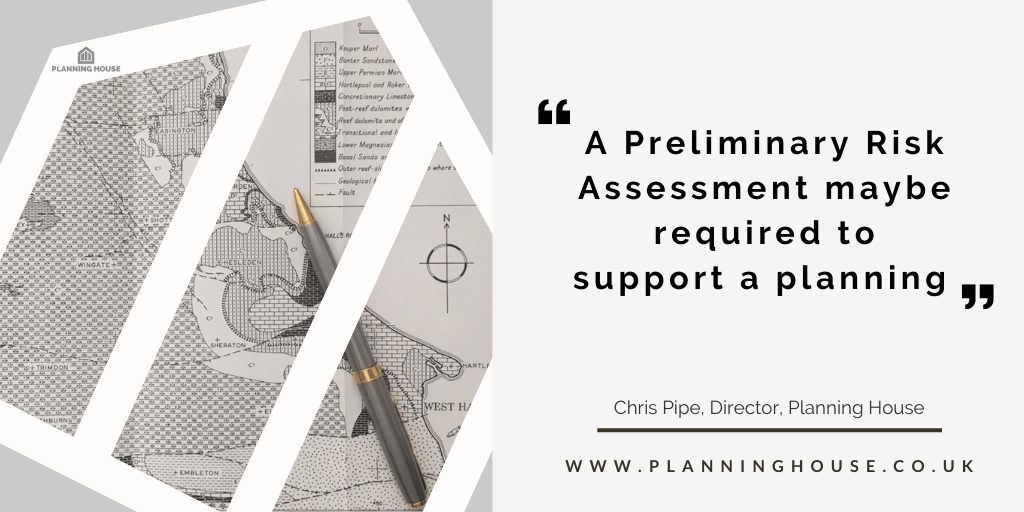Planning House work with some great companies, and one, Northpoint Geotechnical have written a useful article about Preliminary Risk Assessments (PRA) which is a common assessment required to accompany planning applications. A PRA is a desk-top study (non-intrusive) looking at ground conditions for any future development.
Northpoint have provided a brief commentary about what a Preliminary Risk Assessment is and how is the processes undertaken? Naturally if you need any further assistance with PRAs get in touch with Northpoint directly…
What is a Preliminary Risk Assessment?
A Preliminary Risk Assessment (desk study) forms the foundation of any proposed development and future Ground Investigation. Therefore, the desk study phase is a process of identifying potential geo-hazards that may impact a development (such as contaminated land, poor or hazardous geological conditions etc), and allows for the design of an appropriate and targeted Phase 2 Ground Investigation.
A Preliminary Risk Assessment is referred to by different technical names throughout the industry, but the assessment/report is largely the same. For example, a Local Planning Authority may refer to the report as a Phase 1 Desk Study. Other consultants may refer to the study as a Phase 1 or Preliminary Geoenvironmental Appraisal.
What does the assessment involve?
The desk study must include a site walkover (reconnaissance) survey to assess the land for potential contaminants, invasive weed species, tree influence, evidence of potential flooding problems, obstructions, visually assess any obvious utilities runs (such as drains), and assess access/egress for future plant used during the Phase 2 Intrusive Ground Investigation.
The desk study considers historical plans, geological maps and records (including mining and radon) and data relating to landfills, waste, former industrial use and environmental data (such as Environment Agency flood mapping). As a result, this information is used to design the preliminary Conceptual Site Model (Source-Pathway-Receptor relationships) and inform the design of a targeted Phase 2 Ground Investigation.
The process of completing a desk study generally includes:
- Detailed site reconnaissance (walkover) survey
- Coal Mining Risk Assessment (obtained from the Coal Authority)
- Geological Assessment
- Obtain a series of historical plans and information to assess a sites historical use from the mid-1850s to present and assess any pertinent environmental issues / constraints;
- Radon and initial ground gas assessments;
- Preliminary consideration of fluvial/coastal, groundwater and surface water flooding risk;
- Assessment of anticipated ground conditions and any potential risks/constraints; and,
- Preparation of a Conceptual Site Model & Risk Assessment.
The importance of a Preliminary Risk Assessment
Industry standards and good practice guidance acknowledge that a Ground Investigation may be meaningless in the absence of a desk study. Historical site activities may play an important role in determining overall risks and constraints. With the benefit of a Preliminary Risk Assessment, a Ground Investigation can be designed to target historical features and potential areas of concern. These may include areas of potential contamination or relict/buried features (such as basements, foundations, drain runs etc.).
Undertaking a Preliminary Risk Assessment retrospectively following the completion of the Ground Investigation is not good practice. Consequently, we consider this will inevitably lead to a developer needlessly investing more money (and time). Further ground investigation in such instances is normally required.
Related Content
With increasing pressure Councils are becoming increasingly strict in terms of their validation process, don’t underestimate the delays that could be incurred by validation. Take a look at our article Avoid Delays in Validating Planning Application which sets out the potential validation requirements for planning applications and the process.
We’ve published a series of eBooks and Practical Guides along with regular blogs on town planning topics to ensure that you’ve got the basics of the Town Planning system covered. Feel free to take a look through our website, and if you do need some assistance with your development proposal, CONTACT US.
And if you need help with a Preliminary Risk Assessment (PRA), contact Northpoint.


